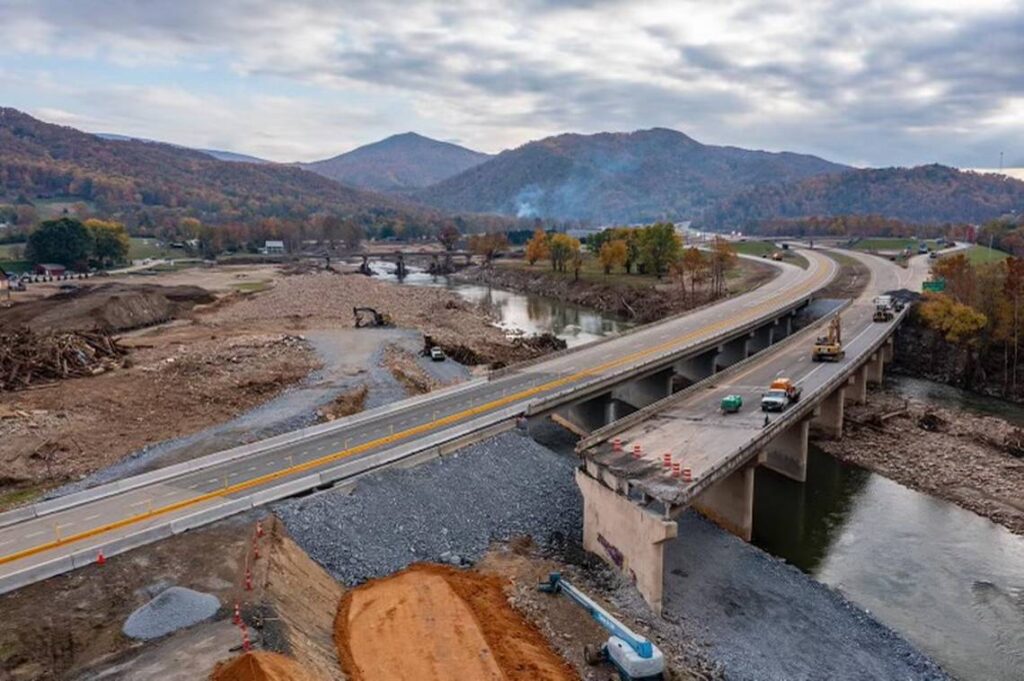Interstate 26 has recently reopened to traffic between North Carolina and Tennessee after being closed due to severe flood damage caused by the remnants of Hurricane Helene. On September 27, rising waters washed out two bridge spans that supported the highway over the Nolichucky River in eastern Tennessee, forcing the closure of this vital transportation route. The flooding not only impacted I-26 but also led to significant disruptions on Interstate 40, significantly severing the direct highway link between the two states. While I-26 has been reinstituted as a thoroughfare, the North Carolina Department of Transportation has yet to announce a timetable for the reopening of I-40, leading to ongoing travel challenges.
In response to the urgent need to restore connectivity, the Tennessee Department of Transportation (TDOT) devised an innovative solution for the damage at the Nolichucky River. Instead of undertaking a lengthy process to replace both spans of the bridge simultaneously, TDOT opted to construct a temporary roadway using 33,000 tons of stone to fill in the gap where the westbound span had washed away. This quick fix allowed traffic to resume in a remarkably short time frame, rapidly restoring the critical link for travelers in East Tennessee. According to TDOT spokesman Mark Nagi, this expedited process deviated from typical protocols, highlighting the importance of this artery for local residents and the effectiveness of collaborative problem-solving in emergency scenarios.
As a temporary measure, the re-established I-26 crossing over the Nolichucky River will remain reduced to one lane, specifically in Erwin, Tennessee, located about 40 miles from the North Carolina state border. This restriction aims to ensure safe passage while bridge reconstruction is underway. However, there are specific limitations as well; vehicles exceeding 12 feet in height are banned from this route, and heavy truck traffic is rerouted through Interstate 81 and Interstate 77 to mitigate potential complications. These adjustments underscore the importance of maintaining infrastructure integrity while prioritizing public safety amidst ongoing recovery efforts.
On the other hand, Interstate 40 on the North Carolina side continues to face challenges, remaining closed west of Exit 20. In Tennessee, where portions of the eastbound lanes have also succumbed to flood damage, I-40 is only accessible to local traffic and deliveries beyond Exit 440. A complete closure is enforced beyond Exit 451, adding to the complexity of travel for those attempting to navigate the impacted regions. The situation on I-40 emphasizes the broader challenges posed by natural disasters on transportation networks, necessitating further assessment and eventual restoration efforts.
As the situation develops, the focus shifts to the reconstruction of the eastbound span of the I-26 bridge. Once it is rebuilt, traffic patterns will adjust, and the temporary road established for the westbound lane will yield to a permanent structure. This strategic planning emphasizes the need for effective contingency measures during natural disasters while recognizing the critical role that interstates play in supporting local economies and providing essential connectivity. By addressing these infrastructures boldly and innovatively, TDOT sets a precedent for swift recovery efforts in the face of adversity.
In conclusion, the reopening of I-26 between North Carolina and Tennessee symbolizes a significant step toward normalcy for the communities affected by Hurricane Helene. While challenges remain—particularly concerning the ongoing closure of I-40—effective responses from agencies such as TDOT showcase the capacity for quick and practical solutions in dire circumstances. The coordinated efforts highlight the importance of infrastructure resilience and proactive planning, particularly as climate-related events grow more frequent and severe. Moving forward, ensuring the integrity and reliability of transportation networks will be vital in safeguarding communities, facilitating commerce, and enhancing regional mobility.

